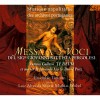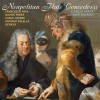传记
Davide Perez (1711 – 30 October 1778) was an Italian opera composer born in Naples of Italian parents, and later resident court composer at Lisbon from 1752.[1] He staged three operas on librettos of Metastasio at Lisbon with huge success in 1753, 1754, and 1755.[2] Following the 1755 Lisbon earthquake, Perez turned from opera more to church music.
Perez was born in Naples, the son of Giovanni Perez and Rosalina Serrari, both Neapolitans.[4] At the age of 11 he became a student at the Conservatorio di S Maria di Loreto in Naples, where he remained until 1733, studying counterpoint with Francesco Mancini, singing and keyboard playing with Giovanni Veneziano, and violin with Francesco Barbella.
On completion of his studies, Perez immediately entered the service of the Sicilian Prince d’Aragona, Naselli. From 1734 date his first known pieces, the Latin cantatas Ilium Palladio astu Subducto Expugnatum and Palladium performed in Palermo’s Collegio della Società di Gesù, for the laurelling festivities. In the following years, he was active both in Palermo and Naples, as his patron became Chamberlain of the newly crowned king, Carlo I. His first opera, La nemica amante, was composed for the king’s birthday on 4 November 1735 and presented in the gardens of the Neapolitan royal palace and later in the Teatro S Bartolomeo. In the libretto’s dedication the impresario of the theatre, Angelo Carasale, referred to Perez and Pergolesi as ‘dei buoni virtuosi di questa città’. Unlike Pergolesi's opera, which was then considered a failure, Perez's was a great success, and his early career granted him, in 1738, an appointment as vicemaestro di cappella at Palermo’s Cappella Palatina, the Church of St. Peter in the royal palace, to become maestro the next year upon the death of its former titular, Pietro Puzzuolo.
In the early 1740s Perez firmly established himself as a mature master. The opera he composed for the Roman Teatro d’Alibert, in the Carnival of 1740, was not presented due to the sudden the death of Pope Clement XII, but on Perez's return to Naples he staged an opera buffa, I travestimenti amorosi and a serenata L’amor pittore for the court, and an opera seria, Il Siroe, for the Teatro San Carlo. Caffarelli and Manzuoli sang in the later.
Opera was not an easy enterprise in Palermo and, until 1745, most of Perez’s compositions as chapel master there were cantatas or serenatas and church music - including in 1742 a setting of Metastasio's oratorio La Passione di Gesù Cristo. In addition he composed church music for Naples, and two operas for the Genovese Carnival season of 1744. After March 1748 Perez was granted a leave of absence and never returned to Palermo, though he continued to receive half of his Palermo salary until his death. In rapid succession, he then staged his operas in Naples, Rome, Florence, Venice, Milan, Turin, and Vienna. In February 1749 Perez competed with Niccolò Jommelli in a public examination for the position as chapel master in the Vatican. The influence of Cardinal Albani and Cardinal Passionei granted Jommelli the appointment, even though Perez was the musicians’ favourite (Girolamo Chiti, the chapel master of another Papal chapel, St. John in Lateran, commented that Perez ‘composes, sings and plays as an angel’ and ‘is very much superior to Jommelli in groundwork, singing and playing. He is, however, an imaginary hypochondriac’).
In 1752 King José I of Portugal invited Perez to become mestre de capela and music master to the royal princesses, a position he occupied until his death. The annual stipend of 2:000$000 (two contos de réis), coupled with the excellent musical and theatrical resources of the Portuguese court, undoubtedly influenced his decision to remain in Lisbon. The ambition of the recently crowned Portuguese king was to depart from his father's musical policy, almost uniquely concerned with church music, and to give Italian opera a central position in the court. Sumptuous scenic treatment was the rule, and Perez’s operas were mounted by such famous designers as Berardi, Dorneau, Bouteux and Galli-Bibiena. Equally important were the great singers who appeared at the Portuguese court, including Raaf, Elisi, Manzuoli, Gizziello and Caffarelli.
The terrible earthquake that destroyed Lisbon on 1 November 1755, changed forever Perez’s output. The court withdrew from the theatres, no operas were produced for the next seven years, and thereafter only in a less spectacular fashion. During the last 23 years of his life, Perez wrote just three new operas. Instead he composed a huge amount of church music, covering almost all the rituals and practices of the two main musical chapels of Lisbon, the Royal and the Seminário da Patriarcal. He never left Portugal, so that his international acclaim slowly declined. Still, Gerber noted that since 1766 Perez’s compositions were known and in demand in Germany and that he was in 1790 ‘one of the most celebrated and beloved composers among the Italian masters … one of the latest composers who maintained the rigour of counterpoint’. J. C. Krause named Hasse, Perez and Paisiello as satisfactory models. In 1774 Perez became by acclamation a member of the London Academy of Ancient Music, and had the only full-scale piece printed in his lifetime, the Mattutino de’ Morti (his third set of the Office of the Dead), published there by Bremner. His music, especially the religious, was widely copied in Italy. During the last four years of his life Perez suffered from a chronic disease, eventually losing his sight, but continued to compose. In 1778 his pupil, now Queen Maria I of Portugal, made him a Knight of the Order of Christ; when he died in Lisbon, she ordered an elaborate funeral at the Crown’s expense.
Perez composed more than 44 dramatic works between 1735 and 1777, 22 operas between 1744 and 1755, the period when he almost exclusively concentrated on the genre. Excerpts from Arminio, La Didone abbandonata, Ezio, Farnace, Solimano and Vologeso were published in London by John Walsh, and at least 24 exist in manuscript.
In the opere serie written before 1752 Perez was often bound by the forms of Metastasian opera. Il Siroe, Andromaca and Alessandro nell’Indie (1744 version) are prime examples: 20 or more full da capo arias (more than half accompanied by strings alone) are consistently used, with between one and four accompanied recitatives, usually a single duet, a perfunctory three-movement sinfonia and a simple choral finale for the principals. The arias are usually written in the Baroque concerto idiom, with extravagant word-painting in the orchestra and extensive vocal bravura passages. Adhering to Metastasio’s prescription of character definition as the sum of a pattern of dramatic reversals, each aria usually depicts a single affect, with few exceptions: Artaserse and Alessandro each contain a scene complex of related arias and accompanied recitatives.
With Demofoonte in 1752, as Perez began his lengthy residence in Lisbon, the monumental idiom declined and a sentimental style gained increasing prominence, with a resultant clarity of texture, greater symmetry of phrase, frequent rhythmic motives and emphasis on the pathetic. Formal modifications include the frequent absence of ritornellos, truncated da capo arias, between five and nine accompanied recitatives and several small ensembles. Perez’s operas of the 1750s frequently display an orchestral mastery superior to that of the contemporary Italian opera school, incorporating features that during the 1740s he could only use in his church music. The strings are in three to five parts, the wind are often used for solo passages, and there is less doubling of the vocal parts and an increase in concertante passages. Among the better examples of this later manner are Olimpiade, Demofoonte, Ipermestra and Alessandro nell’Indie (1755 version).
Demetrio (1766 version) represents a transitional aesthetic, in which Perez combined a modified Baroque dramaturgy with a more up-to-date musical style: he eliminated 14 Metastasio aria texts, used eight accompanied recitatives and two duets for moments of personal reflection, and gave the da capo aria more musical and dramatic coherence. Solimano (1768) is his acknowledged masterpiece. It contains 14 dal segno arias, one cavatina and six accompanied recitatives, the scope and procedures of which are exceptional; several times the individual numbers are integrated into large-scale scene complexes. Kretzschmar (1919) claimed that Solimano ‘belongs under the heading of masterworks … richness of invention and of feeling, originality of means and of form, everything is therein, which makes an art great’ and ‘if all opera composers of the Neapolitan school had been of his stamp, there would have been no need of a Gluck’.








